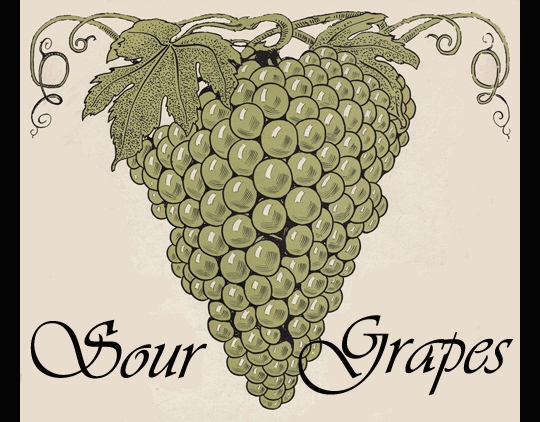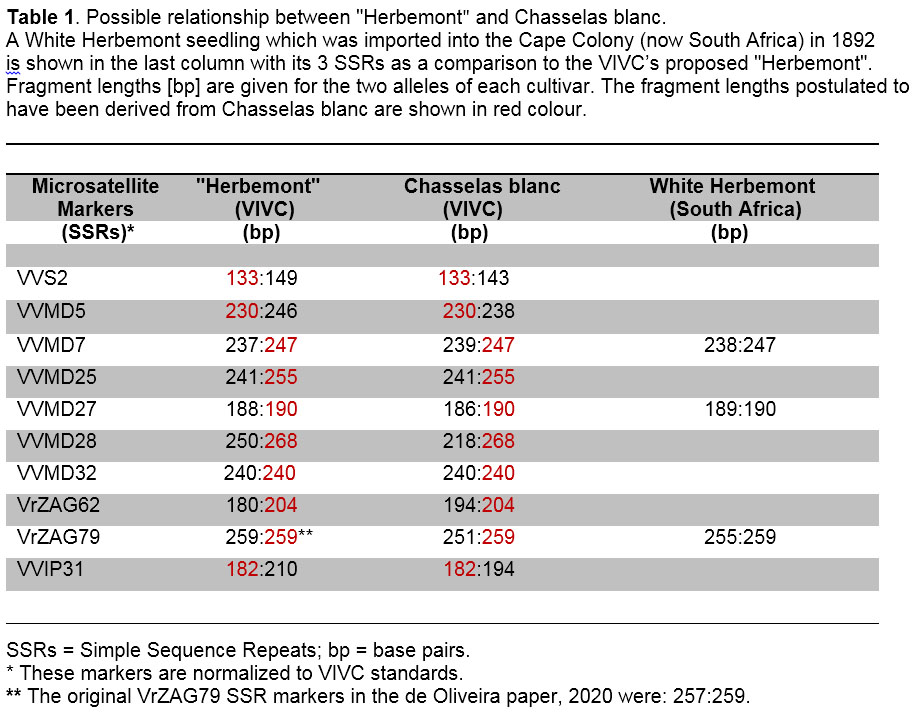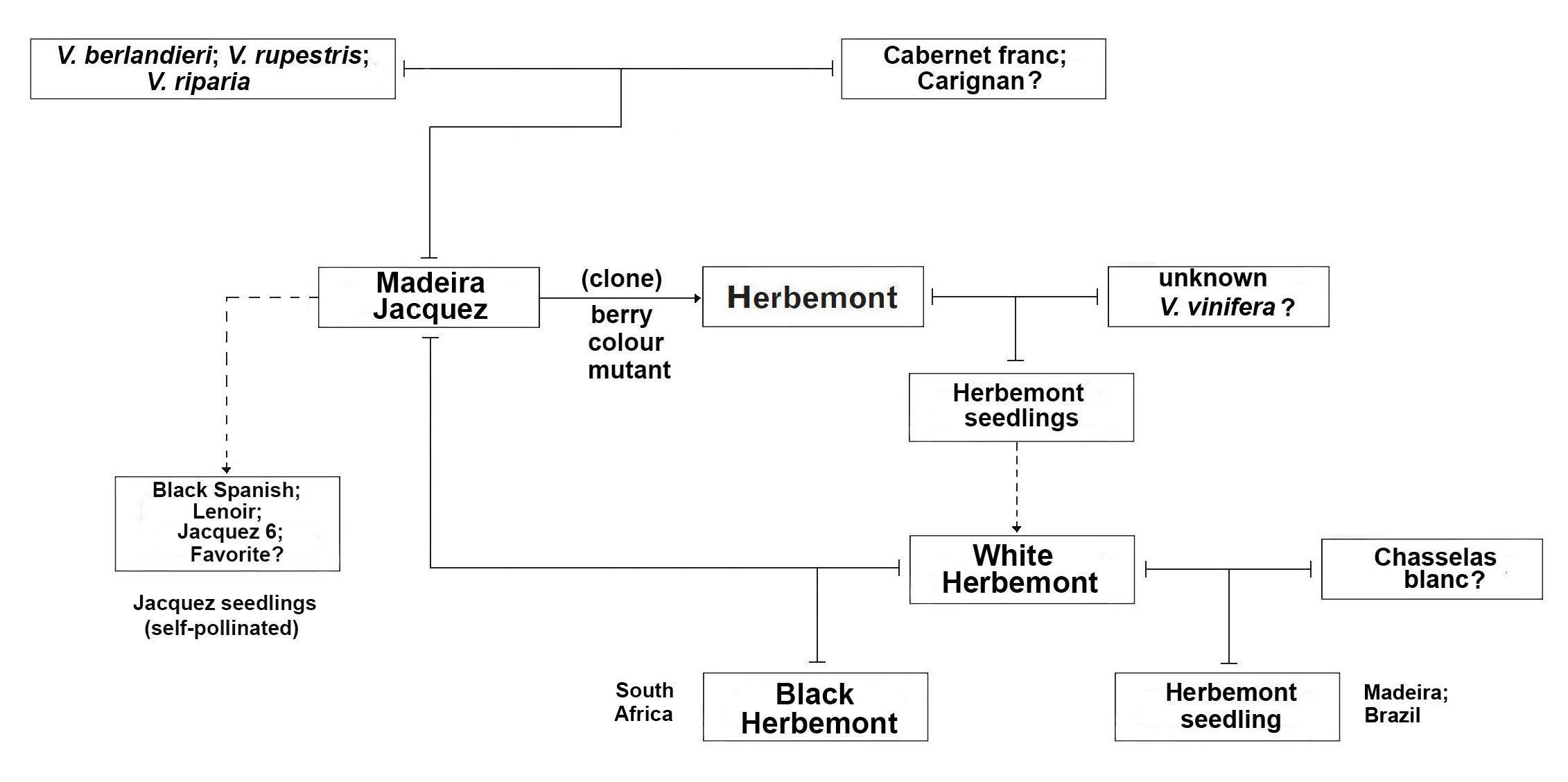The "Herbemont" hybrid grape cultivars in Madeira and Brazil share identical DNA fingerprints – proving they are Herbemont seedlings with the vinifera cultivar, Chasselas blanc, as a parent.
Jeronimo Rodrigues1
3 January, 2021
1Formerly from the Department of Molecular and
Cell Biology, University of Cape Town (UCT), Private Bag, Rondebosch, 7700,
Western Cape, Republic of South Africa.
Email:
dr.jerryrodrigues@gmail.com
DOI: 10.13140/RG.2.2.34767.51364
Summary
The Vitis vinifera background of the "Herbemont" cultivar (previously a.k.a. Brown French; Herbemont’s Madeira; Borgoña in Peru and Borgonha in Rio Grande do Sul, Brazil) was investigated by using DNA Simple Sequence Repeat (SSR) analysis: Chasselas blanc was shown to be a possible vinifera parent of this Herbemont seedling. The hybridization of the two species was, most likely, the result of a random natural pollination event that was followed by successful selection in the field. The original true Herbemont was one of the first natural direct producer hybrids (DPH) to have been used in Madeira and continental Europe. It was also used as a rootstock during the early stages (1860s) of the phylloxera crisis in France and elsewhere, but was soon abandoned because of difficulty in the rooting ability of its dormant cuttings, in addition to its relatively poor phylloxera resistance.
Introduction
It appears that the true Herbemont cultivar is fast
approaching extinction. However, in
certain regions of the world such as Texas in
the US, the Herbemont hybrid cultivar is being actively promoted for white wine
production because it is one of the few naturally occurring hybrids that shows
tolerance to Pierce’s Disease (PD) (Rodrigues, 2016). Another clonally-related PD-tolerant
hybrid cultivar, the Jacquez (
a.k.a. Black Spanish) is used
to make a dark red wine in Texas (Munson, 1909; Santiago et al., 2008 and Yue
et al., 2018).
It is well known that all dormant, rooted Herbemont plants were
summarily uprooted and exported from America to Europe (for grafting purposes) during
the early stages of the phylloxera crisis. During the subsequent 50 years
virtually no Herbemont plants were being propagated in the USA, as a result of
both the economic depression and because of Prohibition (1920-1933).
It is therefore important that the original true Herbemont hybrid
cultivar is positively identified because since the end of the 19
th
century in the US, as well as in France, literally hundreds of Herbemont
seedlings were created and propagated by plant breeders. The most puzzling
aspect with regard to the Herbemont seedlings that have been produced is that
often the adult plants are difficult to differentiate from one another based
solely on ampelographic characteristics. This seems to be a peculiar property
of some American-French hybrids that has caused much confusion in cultivar
labelling, especially in the case of Herbemont.
The Vitis International
Variety Catalogue (VIVC) has documented no less than 16 “synonyms” used in the
past, which include the following: Black Herbemont, Bottsi, Brown French,
Devereux, Dunn, Herbemont's Madeira, Hunt, Kay's Seedling, Madeira, McKnee,
Neal Grape, Neil Grape, Thurmond, Warenton, Warren and Warrenton. This Vitis
database is maintained by Dr Erika Maul of the Julius Kühn-Institut (JKI)
Federal Research Centre for Cultivated Plants.
On the other hand, Dr Erika Maul recently informed the Agricultural
Biodiversity Weblog (in response to a comment) that: "...Herbemont and
Jacquez are maintained in European collections and seem not to be
endangered." She, furthermore pointed out that: "These photos from
VIVC could assist to confirm identification." However, I believe that the identification of
an unknown grapevine by comparing photos of its leaves and bunches, is not a
trivial matter by any stretch of the imagination (Rodrigues, 2019).
Materials and Methods
The "Herbemont" SSR markers have been reported in various
published papers appearing in the literature (
de Oliveira et al., 2020; Marsal et al., 2019). The Vitis International Variety Catalogue
(VIVC) was also consulted for Chasselas blanc and the recently-added "Herbemont"
SSRs (
http://www.vivc.de/) that were based upon
the Brazilian cultivar and elaborated/amended by Dr Erika Maul (
de Oliveira et al., 2020).
One of the two unknown grape molecular SSR profiles originating from Madeira showed an identical DNA SSR fingerprint to the Brazilian "Herbemont" cultivar. That particular unknown cultivar from Madeira is referred to as "Unknown 3IC" in their Supporting Information 3 of their paper (Marsal et al., 2019).
Results
Table 1 provides 10 markers based on DNA Simple Sequence Repeats (SSR) which reveals that "Herbemont" and the vinifera cultivar Chasselas blanc may very well be related to each other.
It also shows 3 SSR markers attributed to the South African White Herbemont seedling cultivar which was originally imported together with Black Herbemont in 1892 to be used as a Direct Producer Hybrid (DPH) and as a rootstock. It was eventually abandoned for the latter purpose due to inadequate phylloxera resistance. Jacquez eventually took over the hugely successful role as a rootstock in South Africa.
Discussion
During his grape-breeding experiments towards the end of the 19th century, T.V. Munson (Texas, USA) produced many Herbemont seedlings. One such seedling was called Black Herbemont (Munson, 1909, Viala and Vermorel, 1909).
According to recent microsatellite DNA fingerprinting analysis (employing 12 markers) it has been established that the Black Herbemont was derived from a crossing between a White Herbemont cultivar (Herbemont OP seedling) and the Madeira Jacquez (Nel and Rodrigues, 2018; Rodrigues, 2018).
Table 1 indicates that the VIVC "Herbemont" is very likely not the original true Herbemont but rather a Herbemont seedling cultivar. Although a more comprehensive list of White Herbemont SSRs would have been desired, a comparison with some of the presently available SSRs points to the possibility that the VIVC "Herbemont" is, in fact, one of the many seedlings of the true Herbemont. Historically, this implies that one of the reasons why phylloxera resistance was lacking in most Herbemont seedlings was precisely because of their higher genetic content of V. vinifera in their genomic composition.
Taking some of the remaining "Herbemont" SSR markers into consideration there are clear indications that some of those SSR alleles have been derived from wild Vitis species such as V. berlandieri or V. aestivalis. For example, the VrZAG62 SSR length of about 180 bp is predominantly found in southern V. aestivalis wild species and not found in V. vinifera. A VrZAG79 SSR value of about 255 – 259 bp is often found in hybrid cultivars from North America. VVMD25 SSR lengths of about 255 bp and VVMD27 SSR lengths of 187 – 188 bp are also found more commonly in American hybrids and in V. aestivalis cultivars than in V. vinifera. Finally, VVMD7 SSR lengths of 237 bp are seldom found in V. vinifera species but occur at a high frequency in hybrids from North America and in V. aestivalis (Stover et al., 2009).
Chasselas is one of the most widely planted white grape varieties in the world and today is considered the leading variety in the European gene pool. Due to its characteristics, it was (and still is) a popular crossbreeding partner for many new varieties. The variety is known to adapt very quickly to different climatic conditions and soils.
The Germans call this ancient grape variety, Gutedel (which means "good and noble") or 'Weisser Gutedel (a.k.a. Chasselas in France, Switzerland and the Alsace region). It is a white wine and table grape variety which is widely planted around the world, though more often as a table grape, for example in Turkey and Hungary. Chasselas blanc is a relatively thick-skinned grape which tends to mature early. This is an advantage for cultivation in the cool Alpine slopes of Switzerland. It is one of the few table grape varieties that is well adapted to cope with the occasional severe winters, and likely it was this property which was inherited by the Herbemont seedlings that allowed it to grow successfully in the cold and humid regions of the south east coast of the US.
The Chasselas is believed to be one of the oldest cultivated grape varieties. It was widely believed that it was cultivated by the Egyptians some 5,000 years ago and then dispersed from the Egyptians to the Romans and the ancient Greeks when trade took place between them. However, according to the Swiss biologist and grape geneticist, Dr. José Vouillamoz, DNA analysis performed in 2009 has revealed that Chasselas is a grape variety which has its origins in western Switzerland (Lake Geneva region) and not Egypt. The exact parentage of Chasselas is presently unknown.
Diagram 1 illustrates how the Herbemont and its seedlings may be genetically related to the original Madeira Jacquez hybrid cultivar. This pedigree is based on the DNA microsatellite markers that are presently available.
Diagram 1. Preliminary pedigree diagram for Jacquez and Herbemont hybrid grapes
Conclusion
The original true Herbemont cultivar with its small bluish-black berries (it is not a teinturier) and beautiful blue bloom is regarded nowadays as a very rare cultivar indeed and could be in danger of becoming extinct. Unfortunately, there is scant microsatellite DNA marker data available for the true Herbemont cultivar. However, some rare Herbemont clones have been located in Peru (called Borgoña) and in South Africa (called 'Black' Herbemont) which have been analysed for microsatellite DNA markers and found to be virtually identical to the Jacquez (Cáceres et al., 2017, Martínez et al., 2006; Rodrigues, 2016).
Therefore, until further confirmatory marker data for the true Herbemont becomes available, we have focused on the marker data of some of the Herbemont seedling cultivars that have become recently available, specifically, the Black and White Herbemont which were imported into South Africa in 1892.
References
Cáceres, H., Quispe, P., Pignataro, D., Orjeda, G. and Lacombe, T., 2017. Caracterización morfológica de variedades de vid para producción de Pisco bajo condiciones de la zona media del valle de Ica, Perú. Scientia Agropecuaria 8(1): 63 – 72.
de Oliveira, G.L., de Souza, A.P., de Oliveira, F.A., Zucchi, M.I., de Souza, L.M. and Moura, M.F. (2020). Genetic structure and molecular diversity of Brazilian grapevine germplasm: Management and use in breeding programs. PLoS One 15(10): e0240665. https://doi.org/10.1371/journal.pone.0240665
Marsal, G., Méndez, J.J., Mateo, J.M., Ferrer, S., Canals, J.M., Zamora, F. and Fort, F. (2019). Molecular characterization of Vitis vinifera L. local cultivars from volcanic areas (Canary Islands and Madeira) using SSR markers.
https://doi.org/10.20870/oeno-one.2019.53.4.2404
Martínez, L.E., Cavagnaro, P.F., Masuelli, R.W. and Zúñiga, M., 2006. SSR-based assessment of genetic diversity in South American Vitis vinifera varieties. Plant Science 170: 1036 – 1044.
Munson, T.V., 1909. Foundations of American Grape Culture. Orange Judd Company, New York.
Nel, A.P. and Rodrigues, J., 2018. The ancient origins of Black Herbemont and Jacquez in South Africa. https://doi.org/10.13140/rg.2.2.16230.88648
Rodrigues, J., 2016. Herbemont hybrid grape cultivar is the most ancient Madeira Jacquez clone: 200-yr old mystery solved. https://www.news24.com/MyNews24/herbemont-hybrid-g...
Rodrigues, J., 2018. View into the grapevine history of Jacquez and its connection to the Madeira Islands – Vitis vinifera cv. Cabernet franc is a possible parent of Jacquez. https://doi.org/10.13140/rg.2.2.31177.65123
Rodrigues, J., 2019. Dr. Jerry Rodrigues of the University of Cape Town hopes for a resolution in a comment on the post: https://agro.biodiver.se/2019/02/featured-herbemont/
Santiago, J.L., Gonzalez, I. Gago, P. Alonso-Villaverde, V. Boso, S. and Martinez, M.C., 2008. Identification of and relationships among a number of teinturier grapevines that expanded across Europe in the early 20th century. Austr. J. Grape Wine Res. 14(3): 223 – 229.
Stover, E., Aradhya, M., Yang, J., Bautista, J. and Dangl, G.S. (2009). Investigations into the Origin of ‘Norton’ Grape using SSR Markers. Proc. Fla. State Hort. Soc. 122:19–24.
Viala, P. and Vermorel, V., 1909. Ampélographie. Tome VII. Masson et Cie, Editeurs, Paris.
Yue, Q., Xu, L., Xiang, G., Yu, X. and Yao, Y., 2018. Characterization of Gene Expression Profile, Phenolic Composition, and Antioxidant Capacity in Red-Fleshed Grape Berries and Their Wines. J. Agric. Food Chem. 66: 7190 – 7199.
Note: A PDF version of my Herbemont paper can be downloaded from ResearchGate at the following URL:
https://www.researchgate.net/publication/348134832



